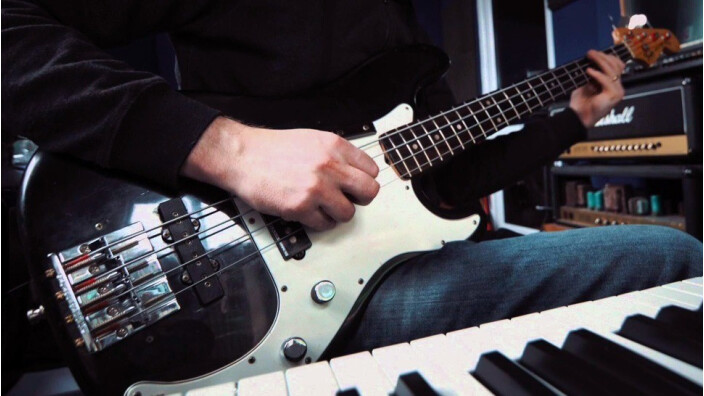Today's topic is somewhat off-topic. In fact, while the tricks you've seen so far allow you to improve "soft" and average electric bass lines, they can certainly be used both during tracking and mixdown, with hardware or plug-ins.

On track
To illustrate this, I took as a starting point one of the recordings made previously, namely the recording of the bass amp (Ampeg SVT-CL head and Ampeg SVT-810E Heritage cab) with a Shure sm57 on axis and almost glued to the grille:

The first trick I will show you is very simple: you only need to add a bit of distortion to the signal so that the bass line stands out from the mix without making it too heavy. To achieve that, and as awkward as it seems, guitar pedals seem to be more fitting than bass pedals, at least for recording and with this particular technique. Indeed, “crunchy” guitar distortion pedals are usually pretty “poor” in the low end of the frequency spectrum, which makes it easier to mix the distorted signal with the original one. In the following example I used the famous Ibanez Tube Screamer:

Sub-mixing it with the original take allows me to give the latter a bit more energy without messing with the low end.
For the two next examples I used the same technique but a bit more boldly thanks to a virtual fuzz pedal. First I targeted the high end with a violent 48 dB/octave low-cut placed around 430 Hz, then targeted towards the lows with a 48 dB/octave placed at around 840 Hz. This is what I got when I mixed it with the source:

- 03 Bass FuzzHi 00:23
- 04 Bass FuzzLo 00:23
Again, the first clip adds more energy to the take, but it is much less subtle. The second makes the sound thicker without making it muddy.
For the next example I used my go-to technique when it comes to highlighting the attack of the notes: add a bit of Bit Crushing in the high end (48 db/octave low-cut at 430 Hz) with the excellent D16 Group Decimort 2 plug-in:

With this processing it is really easy to make the bass line come through without interfering with the rest of the arrangement.
Another very commonly used trick used with e-bass is to mix the source signal with a copy one octave above or below:

- 06 Bass OctDown 00:23
- 07 Bass OctUp 00:23
If you listen to it on its own, it’s hardly transparent. But within the context of a mix nobody will be able to notice it and it will provide more “roundness” to the bass, in case it’s a transposition to a lower octave, or more “definition” if it’s a higher octave.
Finally, there’s nothing better to “fatten up” a bass line than to double it with a synth:

In this example I used the “Sub Engineer Bass” patch included in the Kontakt 5 bass collection. But there are no rules in this regard: a simple sine oscillator can do the trick just fine. Back in the '60s and '70s it was not unusual to use a Rhodes to achieve the same effect, and Roland’s famous JUNO-106 was also used on countless occasions with the same goal in the '80s. Just give it a go with whatever you have at hand!
To finish, I would recommend you to use this technique sparingly or you might end up with an unbearable mush:

For this last example I combined all the techniques described above. As you can see, the result is not really exciting when the goal is to get a bass line worthy of the name. Although it might be interesting if you are looking for a unrealistic “produced” sound!
See you next time for some new adventures in recording.
Download the audio clips (in FLAC format)


